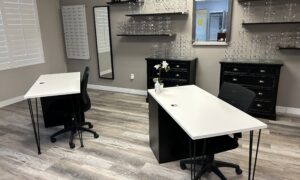By Eric Baas, OD, FAAO,
and Robert Steinmetz, OD, FAAO
 August 15, 2018
August 15, 2018
Starting a practice cold gives you a chance to create a new business from the ground up, realizing your vision of patient care, and delivering your concept of the ideal patient experience.
There are numerous advantages to starting a practice cold compared to purchasing a practice. The most obvious is the purity of the process; you have complete control of all factors from the beginning, and are able to make decisions that align with your mission and goals. You’re able to choose an optimal location, design and customize the space to meet your needs and reflect your style, choose equipment and frame lines, and hire a staff that understands your mission.
As co-founders and principals of iCare Advisors , we have worked with over 75 ODs to start practices cold. It is our mission to help optometrists, who often have a significant amount of student debt, achieve their professional dreams of starting their own practice. We focus on starting lean and growing with your practice rather than overspending and waiting for the practice to catch up, which can lead to delayed success or even failure. Here are keys to keep in mind about the process of building a start-up practice.
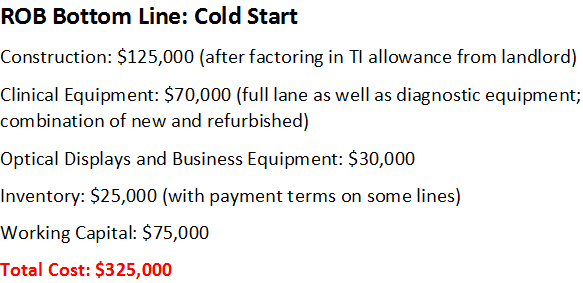 Line Up Finances for Cold Start
Line Up Finances for Cold Start
Starting cold is affordable. The vast majority of our practices are able to start cold for a total cost between $300,000-$325,000. This amount includes all start-up costs (leasehold improvements, equipment, frame inventory, consulting fees and other expenses), as well as working capital needed to support the practice until it becomes profitable.
The current lending climate is favorable and, in most cases, ODs with a credit score above 750 and a good credit history are able to obtain 100 percent financing without having any money saved, and over $200,000 in student loan debt. Unlike conventional loans, which often require the borrower to make a 10-20 percent down payment and go into immediate repayment, these programs are optometry-specific and have graduated repayment terms, which include no payments during the build-out period and partial or interest-only payments for the first 2-3 years of the typical 10-12 year term.
These programs also follow the trajectory of a cold-start practice, and allow them to break even more quickly rather than simply using their loan to repay the loan. It is critical that you build an associating salary into your business plan as you will not be able to financially sustain off of the practice alone initially. These programs require, and we strongly encourage, ODs to continue to work as an associate 2-3 days per week outside of the practice, which allows them to maintain a consistent income, and helps reduce the stress of the process.
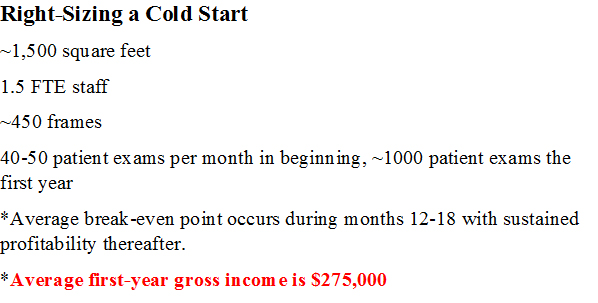 How Do I Pick a Location?
How Do I Pick a Location?
There are multiple factors that go into choosing an optimal location, with the two most important factors being patient demographics and competition. You want to ensure that the type of patients that you are hoping to attract are plentiful in the area, and that the area can support another practice.
One of the best ways to determine demographics is through geo-spatial analysis, such as the program that Vision Source offers, which utilizes GPS data to determine how much individuals spend on eyecare, eyewear and contact lenses per year. You also want to look at census data through resources such as city-data.com or census.gov to determine factors such as population and growth, age distribution and household income.
It is also important to evaluate the competition and determine how you can set yourself apart. We don’t believe competition is necessarily a bad thing, especially when it is predictable. A competitor may have limited hours, an outdated practice, or not offer in-office finishing, which are all elements that you can implement from the beginning to stand out.
Do I Purchase or Lease Office Space?
While most analyses will demonstrate that purchasing is more favorable than leasing in the long run, purchasing is often cost-prohibitive. The purchase price frequently exceeds what a bank is willing to lend in addition to the practice loan, and a 10 percent down payment is typically required, which can also be a barrier for many ODs. Another challenge in purchasing can be finding inventory in more desirable and competitive markets.
Purchasing is not more favorable than leasing if you are sacrificing an optimal location to achieve it. For these reasons, the majority of our clients end up leasing with initial lease terms of 5-10 years with multiple renewal options. We recommend 1,400-1,600 square foot spaces, which helps keep costs down and can still support a muti-million dollar practice. We also negotiate a tenant improvement allowance from the landlord, which helps offset the build-out costs and increases the amount of working capital upon opening.
One of the biggest mistakes we see ODs make is trying to build their 10- or 20-year practice in year one, and overspending to a point that results in delayed profitability and sometimes even failure. An OD may choose to purchase a building after their initial lease term, at which point they have an established brand and are in a much better financial position to do so.
What Equipment Do I Need?
Financial institutions require the borrower to have a portion of their loan comprised of hard-cost assets. Equipment is considered a hard cost, and can consist of approximately $100,000 of the initial budget depending on location and the mission of the practice. This number also includes computers and other items, such as frame displays and office furniture. Equipment costs paid directly to the vendor comprises approximately $70,000 of this number, and can vary based on the practice’s mission statement.
For example, practices that choose to focus on pediatrics may bring in additional vision therapy equipment, and choose to reduce their costs on other diagnostic items that may be more appropriate for an older population. A cold start practice can also reduce start-up costs by purchasing some refurbished equipment with a limited warranty from a trusted equipment vendor.
Essential optometric instrumentation should always be accounted for in the initial budget for a cold-start practice. This includes a chair and stand, slit lamp, digital projection screen, phoroptor, tonometer and lensometer. For cold-start practices that focus on full-scope care in rural environments, advanced diagnostic equipment is often needed, which may include a wide-field imaging system or ocular coherence tomography.
How Much Do I Need to Spend Initially on Inventory?
The cost of inventory can vary based on location and demographic. An initial inventory budget of $25,000 can provide a cold start with a variety of 450-500 frames that can meet the needs of most patients. Many frame manufacturers offer heavy discounts for first-time purchasers of up to 60 percent off to get their product on the shelf. We take full advantage of these programs, and also utilize delayed and extended billing terms that allow a practice to add higher-end lines with a lower upfront cost.
What Are My Staff Needs to Start With?
We look at each of our client’s offices individually, but generally speaking, we recommend one full-time (1.0 FTE) optician and one-part time (.5 FTE) front desk/technician on the days the doctor is seeing patients. This helps ensure that walk-ins can be taken care of by someone experienced in optical if the doctor isn’t in the office, and also helps make patient days run smoothly.
We generally recommend adding staff hours as our clients add doctor days. You want to add staff first, however, and maximize their efficiency before adding doctor days since they are significantly less expensive to employ and can help the OD see more patients within their current schedule.
What Kind of Marketing Do I Need?
We typically recommend making sure our clients have an excellent web presence. This includes a web site and social media pages such as Facebook, Instagram, Google+ and Yelp. Boosting posts on Facebook, as well as advertising on Facebook and Google are two common marketing techniques. By knowing the demographics in the area a practitioner can easily target their patients based on age, gender, interests and geography.
A majority of our clients are young doctors and have a patient base target that includes Millennial populations that are well versed in online interfaces and immediate scheduling options without personal interaction. Self-scheduling opportunities available through electronic health record portals, or third-party providers, are important tools to capture this targeted patient base both during and after hours.
When looking at marketing opportunities, we ask our clients to think about the return on investment. For example, how many patients must be driven into the practice to make the marketing cost-neutral, and hopefully, profitable. If an office’s average revenue per patient is $350 (most of our offices have a higher-than-average revenue per patient), and it’s $500 to sponsor the local little league team, which comes with a banner on the field, your office logo and name on uniforms, it would take 1.5 generated patient leads to make this marketing opportunity cost-neutral. We rarely recommend printed mass mailers because of the poor return on investment and exorbitant upfront costs.
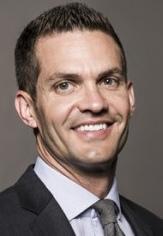 Eric Baas, OD, FAAO, is a co-founder and principal at iCare Advisors LLC, an optometric consultancy specializing in start-ups. Dr. Baas also owns Marketplace Vision in Chicago and teaches practice management at the Illinois College of Optometry. To contact him: drbaas@icareadvisorsllc.com
Eric Baas, OD, FAAO, is a co-founder and principal at iCare Advisors LLC, an optometric consultancy specializing in start-ups. Dr. Baas also owns Marketplace Vision in Chicago and teaches practice management at the Illinois College of Optometry. To contact him: drbaas@icareadvisorsllc.com
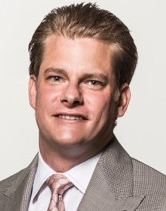 Robert Steinmetz, OD, FAAO, is a co-founder and principal at iCare Advisors LLC, an optometric consultancy specializing in start-ups. Dr. Steinmetz also owns Solo Eye Care and Eyewear Gallery in Chicago. To contact him: drsteinmetz@icareadvisorsllc.com
Robert Steinmetz, OD, FAAO, is a co-founder and principal at iCare Advisors LLC, an optometric consultancy specializing in start-ups. Dr. Steinmetz also owns Solo Eye Care and Eyewear Gallery in Chicago. To contact him: drsteinmetz@icareadvisorsllc.com






